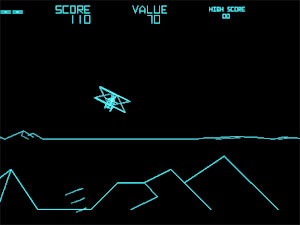Last time, if you recall, we looked at Dave Palmer’s girlfriendless
heroics playing Battlezone at the 1985 Video Game Masters Tournament, where he
managed to break six world high score records in three days. This week, we
examine Red Baron, another of Palmer’s conquests during that epic weekend of
joystick waggling, transparent soft drinks and Goonies
merchandise.

You just don’t see iron crosses, Teutonic lettering and
general symbols of German military expansionism on video game cabinets like you
used to. Atari’s Red Baron, released in 1980, was so festooned with
this sort of thing that it resembled a Nazi phone box. It was also remarkable
as the very first first person flight simulator, and honest Tommies everywhere
will be relieved to learn that the player takes to the skies on the Allied side
for a crack at the Boche. This is rendered with the same vector graphics at
Battlezone, and required an auxiliary motherboard to work out all the 3D bi
plane to-ings and fro-ings. An easier way of spotting similarites between the
two was to peel back the aforementioned German martial themed cabinet
decorations, which would often reveal a Battlezone cabinet lurking
underneath, although this would usually see you beaten up fairly rigourously by
contemporary arcade owners.
As we all know, Fritz does not understand
the notion of fair play and gentlemanly behaviour. However, Red Baron
attempts to address this somewhat by striving for an average playing time,
tweaking the fiendishness of enemy fliers based on the average length of the
previous 32 games – known within the trade as ‘adaptive difficulty’. This
interesting feature was present on many early Atari games, and while it was
doubtless well intentioned – preventing excessive game times – one cannot help
but speculate that it inevitably lead to some Red Barons being more difficult
than others.
 The game itself, in common with the First World War in which it was set, was
The game itself, in common with the First World War in which it was set, was
fairly repetitive, strategy wise. The ghastly Hun would be up to his old
tricks, ambushing the brave lone player with as many as five planes at once,
which would usually swoop down from a distance, allowing sharp shooting Allied
airmen to pick off a couple before they got too close. The greater the
distance, the higher the score, as you might expect. An extremely long ‘kill’
would bring forth a burst of music somewhat reminiscent of being in a cavalry
charge, and this was the game’s only audio feature, except a droning that was
meant to represent the sound of the player’s engine, but didn’t. There was an
element of ground combat, too, with gun turrets and mysterious enemy buildings –
presumably Bratwurst factories, lederhosen warehouses or strudel clubs – which
added a bit of variety.
Our hero Dave Palmer achieved a 214,000 point
score in 1985, which was enough for a world record. Unsatified with his
performance, however, Palmer purchased the game, took it home, and added a
further million points to it. If he had been playing for air miles instead of
points he would have earned enough to buy the universe, but incredibly, he was
still refused a Victoria Cross.
Next week we’ll be revisiting
Firefox, which Palmer also obliterated.

Comments are closed.